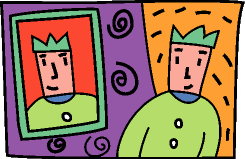Character Development in FictionCharacter #2:The Direct Methods of Character Trait Development |
|
The Direct Methods are the strongest means of communicating a character’s personality traits. They are called "direct" because the reader interprets the traits directly from the character's behaviors. |
All examples below are from Riders of the Purple Sage by Zane Grey. Project Gutenberg E-Text prepared by Bill Brewer * |
ActionsActions speak louder than words and they are the most telling method of interpreting character personality. This is because individuals usually work toward their goals, and goals -- our desires -- define who we are. Character actions can include such things as what a character does in a situation, how a character reacts or treats another character, as well as conscious and unconscious movements and mannerisms. For example, the smoking man on The X-Files was developed through his chain smoking. We see little of his life, but through the actions of his smoking behavior, we interpret his personality. In the example from Zane Grey’s Riders of the Purple Sage, the movement of the mysterious gunman is intended to show he knows gunfight strategy. "The rider stepped away from her, moving out with the same slow, measured stride in which he had approached, and the fact that his action placed her wholly to one side, and him no nearer to Tull and his men, had a penetrating significance." * |
 |
AppearanceClothes make the individual. Character descriptions such as clothing are used to communicate personality. An author does not make such choices arbitrarily. This does not mean that there is a standard interpretation for what a color or style might mean, though. Green can refer to jealousy, to innocence (unripe), or have pastoral (nature) overtones (Gawain & the Green Knight). Appearance is also not limited to looks and dress. It may include odors, character names, sounds, and other visual aspects. Even facial features, hair and eye color, physical size, and other descriptive details in a work of fiction can be chosen to express personality traits. In this excerpt, Zane Grey shows a conflict between clothing appearance and physical appearance. Most readers will judge the physical appearance more significant. "Tull's men appeared under the cottonwoods and led a young man out into the lane. His ragged clothes were those of an outcast. But he stood tall and straight, his wide shoulders flung back, with the muscles of his bound arms rippling and a blue flame of defiance in the gaze he bent on Tull." * |
 |
SpeechDialogue always does more than one thing. Talk is cheap; the fact that the mechanic says your car will be done this afternoon does not mean it will be done this afternoon. The same is true in the literary arts. What a character says, and even what they should say but do not, is often very revealing. Also, how they say it matters. Some people talk so fast you can't understand them. Other just let their sentences trail off.... In the arts, these traits of speech contain personality clues. In this example, Zane Grey establishes Jane Withersteen's strength as she defends Venter to Elder Tull. "Elder Tull, what do you mean by this?" demanded Jane. "If you must arrest Venters you might have the courtesy to wait till he leaves my home. And if you do arrest him it will be adding insult to injury. It's absurd to accuse Venters of being mixed up in that shooting fray in the village last night. He was with me at the time. Besides, he let me take charge of his guns. You're only using this as a pretext. What do you mean to do to Venters?""I'll tell you presently," replied Tull. "But first tell me why you defend this worthless rider?""Worthless!" exclaimed Jane, indignantly. "He's nothing of the kind. He was the best rider I ever had. There's not a reason why I shouldn't champion him and every reason why I should. It's no little shame to me, Elder Tull, that through my friendship he has roused the enmity of my people and become an outcast. Besides I owe him eternal gratitude for saving the life of little Fay." *Here’s a second example. The mysterious rider’s speech is intended to establish him as menace. "But mebbe if you knew who I was--" He hesitated, with his glance on the listening men. "Mebbe you wouldn't let me water him--though I ain't askin' none for myself." * |
 |
ThoughtsIn fiction, the author has the option of allowing readers to "see" or "hear" the character's thoughts. This is usually accomplished through the chosen Point of View of the story. In the third limited or third omniscient point of view, the author has the ability to dip into the thoughts of one or more characters. Some times, in order to delineate the stream of consciousness, the writer uses italics to indicate thoughts. In this example, notice how Zane Grey presents the character’s thoughts and memories: "She wondered if the unrest and strife that had lately come to the little village of Cottonwoods was to involve her. And then she sighed, remembering that her father had founded this remotest border settlement of southern Utah and that he had left it to her. She owned all the ground and many of the cottages. Withersteen House was hers, and the great ranch, with its thousands of cattle, and the swiftest horses of the sage. To her belonged Amber Spring, the water which gave verdure and beauty to the village and made living possible on that wild purple upland waste. She could not escape being involved by whatever befell Cottonwoods." * |
 |
*Grey, Zane. Riders of the Purple Sage Project Gutenberg E-Text/"Project Gutenberg Association / Carnegie-Mellon University." <http://www.promo.net/pg/index.html> |
